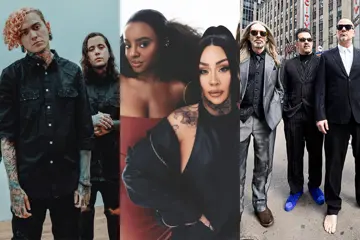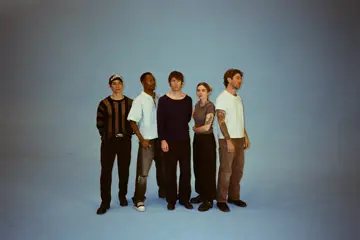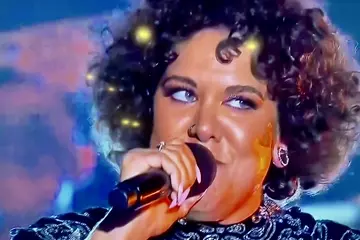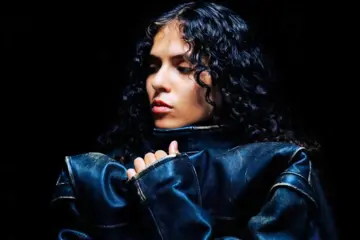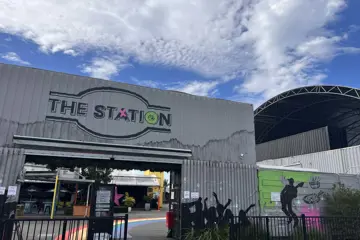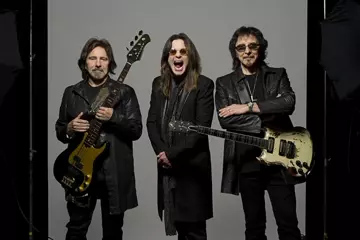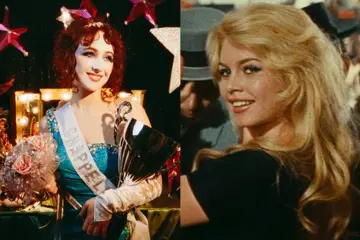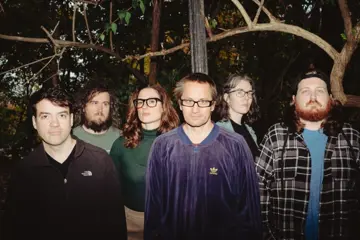The Avalanches won the 2020 Australian Music Prize with their cosmic third album, We Will Always Love You – heavily influenced by epochal British trip-hop, down to the prestigious guests Neneh Cherry and Tricky. Amid the COVID-19 pandemic, the Melburnians have experienced a career resurgence, performing at international festivals such as Coachella and Glastonbury. In fact, Australia has its own history of trip-hop, which evolved through exchanges with English creatives.
Trip-hop originated in portside Bristol – a multicultural hub in England's South West, bearing a sombre association with British colonisation and the Atlantic slave trade – during the '80s. Then known as the Bristol Sound, the music was a product of the city's sound system underground. But the scene's participants were into hip-hop and acid house as much as reggae. Trip-hop would hybridise dub, hip-hop and electronica – adding elements of soul, lounge, psychedelic rock, indie and ambient as textures.
As members of the Wild Bunch sound system, Daddy G, Mushroom and 3D conceived the group Massive Attack, airing their first single, Any Love (helmed by Smith & Mighty), in 1988. Three years on, the trio released the album Blue Lines via Virgin Records – their patrons the aforementioned Cherry, a former punk rocker, and her partner Cameron McVey, who'd had success with Cherry's hip-hop soul debut, Raw Like Sushi (Massive Attack contributed, 3D co-writing Cherry's Manchild). They broke out with the melancholy breakbeat ballad Unfinished Sympathy, sung by Londoner Shara Nelson – one of their core vocalists alongside Horace Andy and Tricky. Blue Lines sounded like nothing before, capturing the popular imagination with an emphasis on mood.
Massive Attack subsequently reunited with Wild Bunch DJ Nellee Hooper (and brought in star singer Tracey Thorn of Everything But The Girl) for their cinematic sequel, Protection. In early 1995 Massive Attack's cohort Tricky unveiled Maxinquaye with his foil Martina Topley-Bird (and a pre-fame Alison Goldfrapp on backing vocals). A post-rapper, Tricky subverted hip-hop idioms, exploring interiority in a genre preoccupied with projection, community and environs. Meanwhile, Portishead was formed by Geoff Barrow, another Massive Attack affiliate, Beth Gibbons and Adrian Utley. They premiered with 1994's filmic Dummy, winning the Mercury Prize over Tricky.
Don't miss a beat with our FREE daily newsletter
A parallel experimental movement gained momentum in the US – San Francisco's DJ Shadow identified with the turntablism (or illbient) subculture. He issued 1996's Endtroducing….., a sample-based masterpiece that presaged The Avalanches, on James Lavelle's curated London label Mo' Wax. Ironically, it was because of Shadow that, two years prior, the Bristol Sound was renamed 'trip-hop'; Mixmag journalist Andy Pemberton devising the descriptor to evoke those atmospheric instrumentals. Still, the genesis of both the trip-hop trend and tag have been contested, most recently following The Guardian's Endtroducing….. retrospective, in which Lavelle stated, "I accidentally invented trip-hop: mixing unusual hip-hop instrumentals with other electronic records to create a soundscape." Ninja Tune bosses (and sample enthusiasts) Coldcut claimed that they introduced trip-hop with their DJ Food vehicle – defining it as instrumental hip-hop.
And so the press rendered 'trip-hop' into an aesthetic – the term applied to Björk, Morcheeba and Moloko. The Bristol originators soon distanced themselves from trip-hop, the prolific Tricky, protesting any racialisation, edging towards (post-)punk. However, the style swept through the music industry. Inevitably, pop's serial reinventors embraced it: Madonna and David Bowie releasing the albums Bedtime Stories and EART HL I NG, respectively. The Bristol Sound phased in drum 'n' bass and dubstep.
Trip-hop went mainstream in Australia but, with a rock-oriented market, there were limits. Tricky was the sole Bristol trip-hopper to headline the Big Day Out, the artist so revered by the global media after Maxinquaye as to unleash a collaborative project with the sardonic title Nearly God. Even at its peak, trip-hop didn't dominate the triple j Hottest 100 like grunge and alternative rock.
The Australian trip-hop scene centred on Sydney. Similarly to the UK, the music's development here was distinct from that of either house or hip-hop, initially being linked to the '80s' rare groove and acid jazz phenomena. The output was again amorphous and transitory. Curiously, some pivotal players were British expats – chief among them Matt Hayward, who, in launching One Movement Records, served as facilitator. He discovered Australia's most prominent trip-hop act, Wicked Beat Sound System – a homegrown Massive Attack. Raised By Wolves, Moonrock and DJ Soup all traversed instrumental terrain.
Trip-hop impacted Australian popdom in unusual ways. Auteur director Baz Luhrmann worked with Nellee Hooper on 1996's iconic William Shakespeare's Romeo + Juliet soundtrack. And, on leaving the pop group Girlfriend, Robyn Loau cut an innovative trip-hop album in Malaria.
The Australian trip-hop wave ushered in local jungle, drum 'n' bass and breakbeat, plus the future soul emanating from Melbourne with Hiatus Kaiyote. Says WBSS founder Damian Robinson, "It's interesting 20 years later to talk about [that scene] because it seemed like a very small thing that was going on. But I think, in a way, it probably has gone down as a moment where Australia shifted a little bit from the rock thing into looking into the use of modern tech to create new things. I don't think we really can claim to have created a new sound; we were not trying to create a new sound. We were listening to music we liked – and we were trying to write stuff that we liked, basically."
Last year the music media celebrated the 30th anniversary of Massive Attack's Blue Lines. Yet today the Bristol Sound is undervalued outside the UK. Of the pioneers, only Cherry has received a significant Grammy nomination, for 1990's 'Best New Artist', which she lost to Milli Vanilli. By the end of the '90s, trip-hop had been gentrified, as with 'downtempo' and 'chill-out'. Still, its influence is tangible in cloud rap and avant 'n' b. Early on, The Weeknd recorded with Doc McKinney of the credible Canadian trip-hop duo Esthero (and sampled Martina Topley-Bird). Latterly, trip-hop has been revived by London Grammar, not to mention Lana Del Rey, FKA twigs and the Bristolian Raleigh Ritchie (aka Jacob Anderson).
In the meantime, the key personnel remain industrious. In 2019 Tricky published an autobiography, Hell Is Round The Corner, once more dismissing reductive classifications – his insights pertinent to Bristol's Black Lives Matter movement. In May, Portishead regrouped to headline War Child UK's Help! benefit for Ukraine in Bristol – and Gibbons features on Kendrick Lamar's Mr Morale & The Big Steppers. Crucially, Cherry has received belated recognition as a trailblazer. But The Avalanches are leading the Australian redux.
A New Wave: Matt Hayward's One Movement Records
It was the English expatriate Matt Hayward who recognised the potential of Australia's fresh sonic hybrids in the '90s, founding One Movement Records in Surry Hills, a Sydney inner-suburb. Over five years, the DIY label released a trilogy of groundbreaking Undertones compilations and signed Wicked Beat Sound System (WBSS).
Coincidentally, Hayward is a Bristolian – although he considers any ties to the city's music hub tenuous. Hayward was born in Bristol but, soon after, his family relocated to Bournemouth on the South Coast. At 19, he arrived in Australia on a working holiday visa, settling in 1990. Still, Hayward bridged the British and Australian subcultures remotely when Internet connectivity was in its early days. "I was in the scene, but telepathically from Australia," Hayward says of Bristol, adding, "I think I was just probably on the same bit of trajectory musically speaking as they were."
 Matt Hayward
Matt Hayward
In Sydney, Hayward DJed under the name Jazzlord and networked, establishing himself as a local identity. He was impressed by the emergent Black music forms being created in the Antipodes, especially acid jazz. "In Australia, when I came out at that time, and I was DJing at quite a few places in the Eastern suburbs in Sydney, the music we were playing was all acid jazz and old school funk and soul and hip-hop." Hayward produced Sydney rare groove band DIG (Directions In Groove). In the interim, he witnessed the Bristol Sound become "more prevalent" with the growing influence of Massive Attack, Tricky and Portishead. But innovative Australian music attracted limited mainstream attention, triple j playlists dominated by alt-rock. Globally, audiences associated Australian fare with Men At Work and INXS.
In 1993 Hayward launched One Movement, initially distributed domestically by Shock Records, then Michael Gudinski's Mushroom. "The idea of setting up the label was borne out of the frustration of there not being enough of the type of music that I liked being played on radio." He aimed to give artists a platform. "There was just no exposure for those people, as there weren't any Australian record labels picking up that stuff and promoting it." Hayward also wanted to validate the music, stressing that he "couldn't fathom" the "insecurity" of homegrown creatives. "A lot of Australians didn't realise how good they were. We've overcome that now. I think 'cultural cringe' is what they used to call it. That doesn't exist anymore, which I'm so happy about. It's something that I was definitely striving to nullify, get rid of, 'cause it was just uncalled for; unnecessary."
Hayward instituted the tastemaking Undertones compilation series – Undertones Vol 1 a triple j 'Album Of The Week'. "At the time, it was so unique – nothing had ever been done like that in Australia," he says. "There was no compilation of Aussie acid jazz/funk/soul/hip-hop." Indeed, the first instalment of Undertones tapped into acid jazz, with songs from Ute, "ambassadors" for Australian music based in London, Sydney's Swoop, and Brisbane's Step It Up – the latter One Movement's flagship album act. Yet Hayward wasn't intentionally cultivating a particular sensibility. "It was quite eclectic, the styles of music that were included on those initial compilations. I think maybe the third one had a slightly more drum 'n' bass tinge to it, but certainly Volumes 1 and 2 went from straight-ahead jazz through to trip-hop through to modern funk or neo-funk – bands like Swoop, for example. But, with some of the artist LPs that we put out and singles, there was no real distinct sound that we were going for. I guess it was just basically stuff that I liked, so not genre-specific."
One Movement enjoyed hits. The label's biggest discovery was Sydney's Wicked Beat Sound System, formerly called Wicked Beats. Hayward had known member Dave Carnovale, aka Crucial D, as a fellow DJ. WBSS broke out with Summer Sun, the Undertones Vol 1 song a triple j fave. "Andy Glitre was mostly to be thanked for that," Hayward recalls of the late DJ. "He flogged it on his primetime slot on triple j." In fact, Hayward credits Glitre with championing Australia's new electronica overall. "He cemented the scene back then."
In 1994 WBSS headlined Joe Conneely's inaugural Vibes On A Summer's Day at the Bondi Pavilion, alongside UK DJs Norman Jay and Gilles Peterson (plus Jazzlord). The boutique festival represented a confluence in the Australian overground, legitimising the rare groove and beat-driven movements.
Meanwhile, Carnovale played Hayward more WBSS tunes – including the cult Local MP, which made 1995's cutting-edge (and most trip-hop-oriented) Undertones 3 and culminated in One Movement issuing their debut album, Music From The Core. Hayward even took the collective to Mushroom. "They had a much deeper pocket, so we thought we would get a better outcome with them putting their weight behind it."
One Movement likewise introduced the underground Hatman – the transitory alias of another English expat, Peter Hemsley. The versatile drummer/percussionist had played with various British bands, notably the neo-progressive Solstice. Hemsley solicited Rani, the soulful daughter of the lounge singer Kamahl, for Undertones 3's drum 'n' bass banger I Have A Dream – afforded high rotation on triple j. Hemsley subsequently conceived The Lord's Garden with Solstice bassist Craig Sunderland, signing to Sony for a double-album, Journeys, which received an ARIA nomination ('Best Dance Release'). He's since returned to England, recently unveiling the ambient Beauty Of Time.
As a curator, Hayward didn't merely seek new acts, either. He unearthed cuts from the likes of Renée Geyer (1975's Sweet Love on Undertones Vol 2) – Geyer intriguing the DJ Eddie Piller, who ran the UK's Acid Jazz Records. "I just remember at the time there was a real big buzz about Renée and her back catalog," Hayward says. Undertones 3 encompassed songs, too, by the chameleonic Deborah Gray – Still Got A Thing anticipating Lana Del Rey. A teen model in the '70s, Gray had pivoted into acting, starring in Aussie soaps, then music. She briefly fronted the synth cabaret duo ARVO, before reinventing herself yet again as a credible jazz vocalist in New York. After Undertones 3, Gray presented an EP, also entitled Still Got A Thing, on Creative Vibes with Roy Hargrove playing trumpet. She is now renowned for writing magic books. Unfortunately, Gray was just in the news as a supporter of the controversial anti-trans activist and Warringah Liberal candidate Katherine Deves, resoundingly defeated in the federal election.
One Movement's arrangement with Mushroom led to an unexpected opportunity. Then working from Mushroom's offices in Chippendale, Hayward canvassed Mds (Mushroom Distribution Services) boss Scott Murphy about releasing a compilation of authentic Australian hip-hop when the scene was but a "proper cottage industry," artists circulating tapes. Hayward A&Red 1995's seminal comp Home Brews Volume 1, complete with an early Koolism track (for the second volume, he brought in Slingshot promoter Trent Roden, staying on as executive producer). And so, indirectly, the trip-hop boom boosted Australian hip-hop.
In 1998 Hayward, feeling "disillusioned", pulled the plug on One Movement. "It was just it wasn't making money." He'd assembled a final collection, the trailblazing Force One: A Compilation Of Australian Drum & Bass. Hayward was dissatisfied at Mushroom, which, not insignificantly, merged with Festival Records that year. "We kind of fell out at the end of that deal. I just didn't feel they were really supporting the releases that we were doing enough."
Hayward had become more involved in production. He was offered the chance to compose a drum 'n' bass track for a toothpaste TV commercial. "The fee for that job was pretty much the same amount that I'd made the whole previous year running One Movement!" Hayward resolved to move into advertising. While he worried about 'selling out' to the corporate sector, Hayward was pragmatic, noting that, "it was not a hard decision." "I was struggling as an independent record label owner. I had a young family and I just had a need to actually start making some money, as opposed to sort of treading water. We didn't make any money out of those Undertones compilations – or any of the releases on the label, really – and whatever we did make got ploughed back into the next release." The Australian market was simply too small.
Hayward has been buoyed by the Australian scene's diversification over the last three decades, listeners also now familiar with different sounds. "One of my very few regrets in life is that I didn't push on with the label – 'cause obviously since then Australian music, and Black music specifically, has just gone from strength to strength."
Today Hayward has his own company, MusicBrief, delivering bespoke music for brands. However, he still records electronica, bedroom-style, as Jazzlord. "It's my little side-hustle – it's not a monetary thing; it's just something I do for fun," Hayward says. "One day maybe the Jazzlord will crack the big time!"
One Movement's catalog isn't on streaming services – but Hayward would welcome reissues, if someone else assumed the business role (he does have the music available on SoundCloud). "It's absolutely possible," Hayward states. "I think it would come down to a monetary decision from someone, 'cause ultimately it would need to have a lot of those tracks relicensed… There'd be a fair bit of admin work tracking down the original owners of the copyright into the songs to get their permission in order to do that. But it's entirely doable."
Wicked Beat Sound System: The Supergroup
Sydney's Wicked Beat Sound System (WBSS) emerged as Australia's biggest trip-hop act, transcending any underground scene. WBSS were featured on One Movement Records' Undertones compilations and released a trailblazing album in 1996's Music From The Core, with the epic sweep of Massive Attack's Blue Lines. "Wicked Beats were the lucky ones, in a way, because we had the hits," says co-founder Damian Robinson.
WBSS evolved out of a night, Wicked Beats, hosted at the Bentley Bar in Surry Hills from 1991. Like Massive Attack, the group originated as a sound system, but their vocalists were full members. "In fact, we never really thought of setting up a band, as such," Robinson remembers.
Robinson, then in his late 20s, had a background in bands, playing guitar. He was working as an audio engineer at the Sydney Opera House, which, significantly, gave him access to gear. Robinson befriended Dave Carnovale (aka Crucial D), a DJ and manager of the Bentley pub. He was intrigued by hip-hop and started experimenting with samplers, harnessing the Akai X7000 keyboard – technology pivotal to the new electronic forms. "I think the reason why it was such an interesting movement around the world was 'cause it was quite difficult to know how to use the tech back then." Carnovale had the record collection for sampling – and was a reggae fan. The pair were "mucking around in the studio," laying down instrumentals.
Jamming at the Bentley, Robinson and Carnovale were accompanied by the Kiwi MC/toaster KYE and singer Linda Janssen (of the funk collective Bellydance), plus musicians. Robinson would sample the guests live, then replay, as Carnovale DJed, reconfiguring acoustica and electronica. The fold determined to record earnestly. "We weren't trying to be innovative," Robinson says. "[WBSS] did evolve quite organically." Nor did they perceive themselves as part of a wider community. "We didn't realise that we were a movement."
 Pic via wickedbeatsoundsystem.com
Pic via wickedbeatsoundsystem.com
Robinson admits that, in addition to soundclash culture, the Bristol Sound was an inspiration. "I suppose a big early influence for us was probably Massive Attack; their early stuff – Blue Lines, that kind of sound. We didn't model on ourselves on that, but we were interested in that melding of electronica and dub." He also admired Nellee Hooper's production on Protection, Massive Attack's second album. "I really liked how he managed to keep a slight pop sensibility, but still maintain a really lovely grittiness to his sound." But there was a precursor for Australian dub, with Sheriff Lindo active in the '80s. However, WBSS weren't aiming to become "the Australian version of an overseas band." Today Robinson commends One Movement's Matt Hayward for identifying a nascent scene, using his "English nous" to market it. "Matt deserves a large amount of credit for doing that," he says. "I think, more than anyone else, he realised the potential of what was happening in Sydney in the '90s."
WBSS broke out with the reggae groove anthem Summer Sun – included on 1993's Undertones Vol 1, alongside Inside. The group felt ambivalent about Summer Sun, despite Hayward's insistence that it was "a hit". "That song, none of us liked when we wrote it," Robinson reveals. "It was like, 'It's way too cheesy – let's not release it!'" They preferred the cult (and dramatic) protest song Local MP on Undertones 3 (and with a video directed by Nicole Fossati). "We were so happy with that track – I mean, I still think that's a great track. It's got a lovely dark thing going on in the beats and Linda's vocals are fantastic."
Inking a two-album deal with One Movement, WBSS assembled Music From The Core – entailing a remix of Local MP. Hayward connected them with the Brit Jeremy Allom, a mixing engineer on Blue Lines who'd migrated to Australia. "We worked in the studio with him for a bit – and that was interesting to do that as well, because he was a really well-known producer at the time," Robinson says. "He'd worked with a lot of sounds that we were doing already." (Allom was likewise involved in Vika & Linda's buzz 1996 foray, Princess Tabu.)
WBSS subsequently aligned themselves with Mushroom Records, which reissued Music From The Core – and, in 1997, they received their first ARIA nomination for 'Best Dance Release'. WBSS consolidated their profile with 2000's Inna Styles, taking in Janssen's tuneful Don't Wanna Know. But the posse didn't reckon they belonged on Mushroom's rock-oriented roster. "We were little boys playing with the loopy [stuff]," Robinson notes. "We weren't really given much credence within the label at all." WBSS were validated when triple j made Inna Styles its 'Album Of The Week', only that mainstream recognition proved counter-productive. "Then Mushroom tried to mould us into a rockier version of ourselves – and we didn't like that at all."
WBSS were popular on the national live circuit. Initially, they were the go-to support for acid jazz bands. WBSS prestigiously opened for the Fugees on their sole Australian tour. And the group were huge in Perth. Robinson recalls that WBSS once had autograph-seekers at the airport – "which, for an underground beats-driven thing, wasn't something that we expected."
WBSS generated international buzz, too. "There was interest in Europe," Robinson says. "We sold lots of records over there – probably more records in Europe than in Australia!" WBSS licensed music to the French film Clubbed To Death (Lola), itself titled after Australian Rob Dougan's Mo' Wax hit. But, though they had opportunities, WBSS never toured abroad, primarily due to the members' growing family commitments – "a shame". Janssen had already been gigging while pregnant, even when supporting Ben Harper. "We had a few close calls," Robinson shares. "It wasn't just all beer and skittles." WBSS did not benefit from having the direction of a management team, either. "We were very difficult to manage," Robinson quips. "We were unruly."
Post-Inna Styles, WBSS split from Mushroom – which had merged with Festival Records – and joined Roadshow Music. Ever the maximalists, the group continued to explore other neoteric sounds: drum 'n' bass, nu-skool breaks, and future soul. "We didn't really feel at the time that we were incredibly groundbreaking," Robinson reiterates. "We were just a couple of kids smoking a lot of pot and having a lot of fun. It really wasn't until about the third or fourth album when we'd signed with major record labels and were getting all this pressure – I think that's when things became more serious for us, in the sense that there were expectations for us to write hit songs all the time, and [that led to] the demise of the band in a lot of ways. We moved on from that 'just sitting in the bedroom and having fun.' It became a job."
Alas, in the early 2000s, WBSS began fragmenting. The very expansiveness that ensured the outfit was so distinctive caused friction, Janssen leaning into deep soul and KYE hip-hop. "There was a lot of struggle," Robinson enlightens. "I think, at first, when it wasn't important, there was no problem changing genres. But, as everyone became more aware that we were creating something that people were listening to, there was more push and shove on what direction we took. So, each album, there were swings and roundabouts according to where we were heading. Ironically, the album that put us on the map, which I think is Inna Styles, was, in a way, a very eclectic album. It hit town right at a time where Australia didn't have any of those sort of things going on."
In 2003 Carnovale drifted away from WBSS, followed by KYE two years later – the MC developing his side-project, Budspells. "He'd had enough of the eclectic-ness of what we were doing," Robinson concludes. The members were also facing "financial pressures" – and, Robinson rues, "a bit of reality set in." By now a duo, WBSS's last album proper was 2007's Hydromajestik. "We ended up basically deciding that it's probably best we just call it [quits] – we never actually officially did call it, though."
Robinson has since pursued a "second career" as a cattle and truffle farmer on his wife's family property in Bungendore. Yet he still produces music for arts commissions, and is passionate about collaborating with First Nations musicians, repurposing the WBSS handle. Robinson has "no aversion" to a WBSS comeback (he's archived their history online), albeit with some qualifications. "I do cringe when I see old blokes on stage playing the stuff they wrote 20 years before – I don't really wanna be like that! There may be a point where we all get together and write new material and then perform that – I wouldn't mind doing that. But I really don't wanna go back and do Summer Sun."




